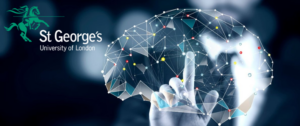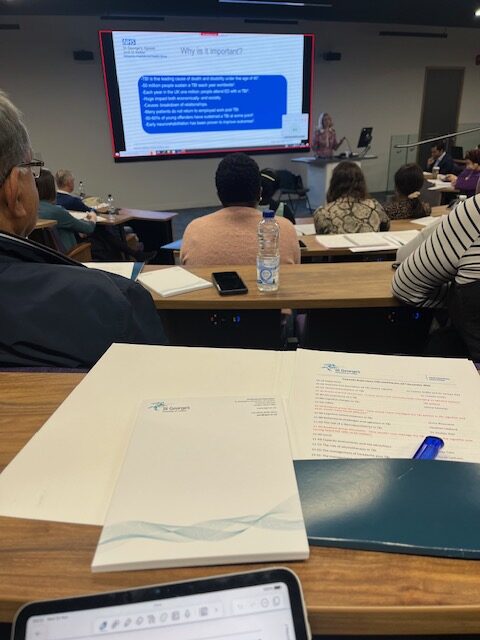
This was an excellent, comprehensive and interactive teaching course led by Dr Colette Griffin and Dr Akshay Nair. Dr Griffin is recognised globally for her work in traumatic brain injury (TBI) and leads the TBI service at St George’s Hospital in London. There was an incredible array of speakers from the multi disciplinary team – including physiotherapists, psychologists, speech and language therapists as well as neurologists, neurosurgeons and neuropsychiatrists. The need for collaborative work, persistence and patience was emphasised. Recovery can be prolonged and hope must be preserved.
The absolute highlight of the day was a truly moving talk given by a survivor of TBI. This patient sustained a traumatic brain injury when he was only 20 years old, and hearing how it completely changed the course of his life and the journey he has gone through over the past 9 years brought me to tears. I really can’t even describe the talk to do it justice, but it really put everything we do into perspective and again reinforced the need for patience, resilience and most importantly hope. His speech was eloquent and especially impressive given that it was the first time he has spoken publicly since the injury.
Clinical Presentations of TBI
Dr Colette Griffin, Neurologist
This was a great introduction to the varying presentation of TBI and the main causes (the most common of which is road traffic accidents). The global impact of TBI is shocking, with an estimated annual cost of 33 billion Euros annually in Europe alone. Dr Griffin discussed the classification of TBI and how this helps to stratify patients. She also spoke of medical conditions that can co-exist and exacerbate symptoms related to TBI, such as agitation. Post-traumatic epilepsy was discussed and also commonly occurring endocrine abnormalities.
Surgical aspects of traumatic brain injury
Mrs Fay Greenway, Consultant Neurosurgeon at St George’s
As the neurosurgery representative of the TBI team at St George’s Hospital, Mrs Fay Greenway presented the surgical aspects of traumatic brain injury. The talk covered the basic physiology of brain autoregulation and the pathophysiology of TBI; using a variety of cases to illustrate different injuries, from extradural haematoma, to diffuse TBI. It covered principles of acute management of TBI – from intracranial pressure monitoring to surgical options, touching on some of the nuances and challenges of decision making in severe head injury – when to operate or not. It highlighted the importance of shared decision making with the families of patients, seeking to understand what the patient themselves would have wanted. The surgical aspect of TBI is very much one, small, part of the care of patients with TBI – recognising the importance of active engagement with the wider TBI team, and valuing everyone’s role, is vital for any effective TBI service.
Experience of TBI – from the TBI survivor
Hearing how this patient’s TBI completely changed the path of his life was honestly amazing and moving. Moreover, hearing how he has adapted and overcome such challenging times was inspiring. He has experienced many of the commonly associated conditions associated with TBI, including a huge effect on his cognitive ability. This was very well described, including the period when he was “unaware of his deficits”.
Cognitive changes in TBI
Jean Hardy, Neuro OT
This lecture broke down how TBI can affect the “cognitive system”, which I found very interesting. Post-traumatic amnesia (PTA) was explained, and its importance including how its duration can offer indication of the severity of the TBI and the persistence of cognitive impairment. Measuring tools of PTA were discussed and the need to identify and assess this condition early on was reiterated. Practical advice was given to help patients through this period of PTA including doing things like showing them their scans, reviewing triggers for their agitation, preventing over stimulation and importantly being patient and reassuring.

Cognitive Communication in TBI
Phoebe Bill, Speech and Language Therapist
This lecture was also very informative and discussed cognitive communication disorders (CCD) which can arise in TBI (also can occur post stroke and in neurodegenerative diseases). Features of CCD were discussed, and Jenna explained that this can be on a continuum (i.e. some people are more hypoactive and others might be more verbose and hyperactive). I found it interesting that how people were before their TBI can sometimes impact where they lie on the spectrum. Various cognitive assessment tools were discussed and how to use them. Support strategies for the various manifestations were also broken down and explained, which was very useful – for example if the patient is more verbose vs tangential. CCD is one of the biggest predictors in patients returning to work, highlighting its importance.
Behavioural Challenges and Agitation in TBI
Dr Akshay Nair (on behalf of Luke Goodliffe, Neuropsychologist, who was unwell on the day)
“Challenging behaviour” was defined and discussed in detail, in relation to TBI. Importantly it was explained that behaviour is a form of communication. Different factors contributing to behaviour were discussed including emotional factors. Considering how the person was before the injury is very important. Previously undiagnosed neurodevelopmental disorders such as autism can even present post TBI. It was again reiterated to pay attention to anything that could exacerbate challenging behaviour such as medical conditions, delirium, social isolation and drug withdrawal. Assessment and formation was discussed as well as necessary interventions. The main learning point was to be proactive as opposed to reactive, and to think about interventions as the individual, the environment and the communication itself.
Role of the Neuropsychiatrist in TBI
Dr Akshay Nair, Neuropsychiatrist
Dr Nair explained what a Neuropsychiatrist is, i.e. a psychiatrist who focuses on organic neurological conditions with associated psychiatric co morbidities. His area of focus is TBI and Huntington’s. He explained the role of the neuropsychiatrist in TBI assessment and management. He explained their role is more in the acute on to subacute and chronic vs the hyperacute. He explained the importance of not treating where possible, and if in the extreme case treatment is needed, to think about this carefully and focus the treatment accordingly. He also advocated to “start low and go slow”. When trying to treat with psychiatric medications in TBI, they will not work in the same way as the brain network has been interrupted.
He detailed what is involved in a psychiatric formulation and how he does this with TBI patients in various stages of their injury. It is important for TBI patients to have access to psychiatric treatment throughout the course of their lifetime.
Capacity assessments – Mental Capacity Assessment (MCA) and Deprivation of Liberty (DoLS)
Sally Elliott, Safeguarding Lead at St Georges
This lecture detailed the elements of the capacity assessment – the 5 principles being that you should always presume capacity, to support individuals to make their own decisions, that everyone has the right to make their own decisions, that decisions made by clinicians for those who lack capacity should be in the best interest of the individual, and also that if there is a need to be restrictive in any way clinicians must choose the least restrictive option. Deprivation of liberty was explained also which was very useful. These were related to TBI patients, and the importance of thinking of how to use the MCA and DoLS in their management.
The role of physiotherapy
Kalpesh Patel, Neurophysiotherapist
Physiotherapists play a key role in the management of TBI patients. He discussed the importance of explaining why various braces were needed and how this communication to patients is key. They assess capacity and confused patients, and help to adopt measures to reduce this confusion and agitation including ensuring consistency, schedules and behaviour guidelines amongst others. They also assess and treat benign paroxysmal positional vertigo (BPPV) – diagnosing with Dix-Hallpike and treating with the Epley Manoeuvre, and do balance assessments.
The management of headache post TBI
Dr Ivy Ong, Neurologist
Dr Ong spoke about headaches in the context of TBI. She discussed cases, importantly highlighting that when we see these patients it is important to see things with “fresh eyes” and always challenge and revisit the diagnosis when something does not “add up”. It is easy to assume the headache is due to TBI, so it is important to consider re-scanning and reviewing investigations. She spoke of the main phenotypes of headache seen with TBI, and also reiterated the need for a detailed headache history to be able to tease out these various features. She discussed investigations and then management options. She spoke of specific medications that are more or less useful depending on the type of headache, and also the role of mood stabilisers and antipsychotic medications. I found it very interesting to hear about her scientific research projects on mice models, and how this translates to current theories of the pathogenesis of TBI headache. She spoke of newer therapies being reviewed including CGRP inhibitors which will be an exciting area to follow.
The management of vertigo post TBI
Dr Hena Ahmad, Neurologist
This was an excellent and clinically relevant lecture not just for TBI but for any patient presenting with dizziness. Dr Ahmad explained how we should think about dizziness as a symptom and how to elucidate this from patients. She then spoke of the most common causes of dizziness in TBI, including benign paroxysmal positional (with other common causes including vestibular migraine and Ménière’s disease). Dizziness is a very important symptom to try to manage in TBI patients, as it is an independent predictor of whether someone will go back to work. Dizziness can be disabling and last several years following the initial injury. Dr Ahmad discussed how dizziness should be assessed clinically, including the use of assessment of eye movements and cranial nerves as well as using HINTs (head impulse, nystagmus, test of skew). She discussed important aspects of management for these patients – for example with BPPV the use of the .

